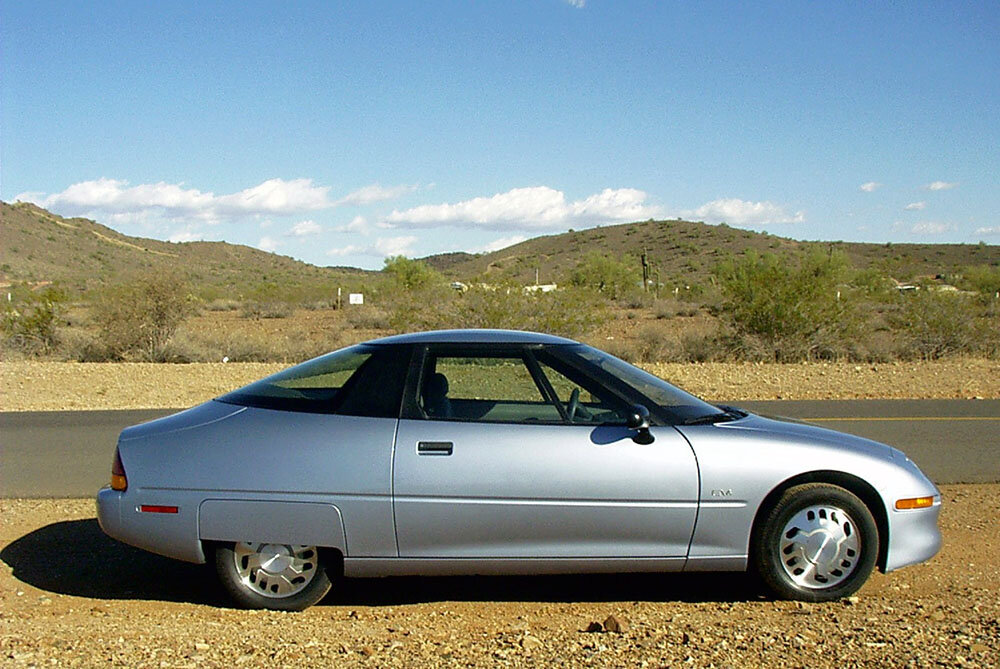
What GM’s Pledge Means For EVs
In this past week we have witnessed a somewhat historic pledge from General Motors – once the world’s largest automotive manufacturer – that it will stop making internal combustion engine vehicles by 2035, and will seek to become carbon neutral by 2040.
This message has been driven home by a no-expenses-spared Superbowl advert featuring Will Ferrell to highlight the brand’s commitment to producing electric vehicles.
This was an unthinkable prospect just a year ago.
Today we look at what this announcement means for the future of electric vehicles, the Climate Crisis – and how GM could have kick-started the EV revolution in the 1990s.
Why Does This Matter?
While the number of EV models has increased exponentially in recent years, established automotive manufacturers have been pretty slow to respond to the rapid increase in demand for zero-emissions, battery electric vehicles.
Many have sunk a significant portion of their budget into promoting hybrids, which have been marketed as a ‘green’ solution despite clear scientific data demonstrating how harmful they are to human- and planetary-health.
Furthermore, where some have committed to producing EVs over the past decade, these cars have often represented a way to meet emissions targets – as explained in our Emissions Pooling article.
Yet, in 2020 we witnessed a marked change in the number of traditional car manufacturers pledging to either go EV-only in the near future, or to dramatically increase the number of battery electric vehicles in their line-up.
Consumer demand and public awareness of the severity of the Climate Crisis has led this change in approach – while the rapid growth in the popularity and stock market value of Tesla has certain made an impact. As has the number of countries pledging to ban ICEs from 2030 onwards.
This will make a genuine impact on the price of EVs, as mass manufacturing and competition will bring price parity or even make electric models cheaper than traditional petrol or diesel cars. It will also increase the types of cars available, meaning that there will be a wider selection to meet the demands of different consumers.
Should We Be Cautious?
While GM has pledged to invest $27bn in electric vehicles between 2020-2025, there are some causes for caution.
Firstly, we should be cautious about the definition of ‘electric’ vehicles.
Far too many manufacturers refer to plug-in hybrids and hybrid vehicles as ‘electric’ when they are still reliant on burning petrol or diesel as their primary source of propulsion. Hybrids are not ‘clean’ or ‘green’, despite their marketing and are simply internal combustion engines in disguise.
The only vehicles that align with our aims of tackling the climate crisis are battery electric vehicles (BEVs).
Transport is a major contributor to global greenhouse gas emissions. Credit: CIE
Of course, we should also be cautious and conscious of the factors that have led GM to make this commitment. As always, the answer is money.
They know that the shift in consumer attitude and in political will means that their current range of products has a limited lifespan, and that they need to make this move to maintain their profit margins. For reference, they made a profit of $6.85 billion in 2019 alone.
Finally, while they will be marketing electric vehicles with low- or zero-emissions, it does not mean that their processes for manufacturing, or even the parts that they choose, will be sustainable. See our articles on Ethical Car Design for more.
If they are to churn out a high volume of profitable electric cars, it is up to consumers and regulators to ensure that these vehicles are as ecologically responsible as possible – from how the batteries are made and sourced, to how they have been designed to be repaired and recycled.
We cannot afford to assume that the manufacturer and disposal of these vehicles will be more ethical and have a lesser impact on the Climate Crisis than their current petrol and diesel line up – and it is up to us to hold them responsible.
We should also take this as an opportunity to remember that GM spent $25,000 last year alone to re-elect climate deniers to the US Senate. For more on this, we highly recommend reading Emily Atkin’s in-depth article on Heated.
What Could Have Been
While General Motors is making a lot of noise about its electric future, it has been very quick to forget its early forays into the EV market.
Back in 1996, GM launched the world’s first mass-produced, purpose-built electric car: the EV1.
The first generation EV1 was powered by lead-acid batteries and offered consumers a range of 70-100 miles (112km-160km) for a leasing price of $399-549 per month, which is incredibly impressive for the time.
Even though the batteries it used were already a little out-dated, the Vice President for Marketing at GM, Joe Kennedy, remarked at the time: “Let us not forget that technology starts small and grows slowly before technology improves and costs go down.”
The EV1 quickly became a cult hit, and the roll-out of a second generation in 1999 brought significant upgrades to the batteries and a huge waiting list as buyers clamoured to get their hands on the zero-emissions car.
However, the promise of the EV1 was short-lived and has left a stain on GM’s reputation that persists to this day.
In 2000, General Motors began a rapid recall and discontinuation of the EV1, terminating the leases of all existing cars and removing thousands of people from their waiting lists.
General Motors EV1. Credit: Wikipedia Creative Commons License
Those cars that had already been leased were rounded up and crushed, despite being fully functional vehicles and their current owners offering to pay the remainder of the lease value – an offer that GM never responded to.
A number of factors have been blamed over the intervening years, including:
GM focusing on its Hummer and truck brands, which were cheaper to manufacturer and which offered a greater percentage of income over their lifetime – the EV1 did not require regular servicing, oil changes or brake replacements, so would represent a loss of an revenue streams for General Motors
Chevron purchasing the patents and controlling interest of the EV1’s battery manufacturer to prevent their production, so that the oil giant’s profits were not diminished by a rise in demand for electric vehicles
Hard lobbying from the oil industry to lower fuel prices and spread disinformation about electric cars – something that we’re still seeing to this day with renewed investment in greenwashing campaigns
The fact remains that the EV1 was not mothballed because it wasn’t a good car or that people didn’t want it – GM’s motivations were based solely in long-term profit, and not in the ethical interests that it claims to espouse today.
In fact, it would seem that GM is so eager to detach itself from this part of its history that it has deliberately removed all references to the EV from its marketing about its Path To An All-Electric Future.
Amidst GM’s highly-marketed pledge to become a more ethical and sustainable car manufacturer, it’s hard not to think where we could have been 25 years on if they had committed to making a success of the EV1. The emissions and lives that could have been saved, and just how affordable EVs could have been with the advances in technology over that time.
If you’re interested in learning more about the EV1, the controversial circumstances around its discontinuation, and the consequences for the Climate Crisis, we highly recommend watching the 2006 documentary Who Killed The Electric Car.
Make it stand out.
Beware of False Prophets & Maintaining Profits
Discover how greenwashing is being used to give false hope and diminish brands' ecological responsibilities in the eyes of consumers - as exemplified by Jaguar’s latest announcement
Climate Crisis Documentaries to Reassure & Inspire You
To help inspire you to act on the Climate Crisis, and reassure you that we already have the solutions at our fingertips, we present a spoiler-free list of our favourite documentaries that pave the way towards a better, more sustainable world





